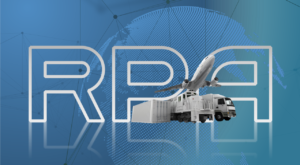Robotic process automation (RPA) sits on the doorstep of artificial intelligence (AI). Some analysts have described RPA as a gateway technology to AI. Priya Dialani (@priyadialani248) writes, “Artificial intelligence is without a doubt on everybody’s radar, except all the more explicitly, robotic process automation, the subset of AI that empowers IT groups to configure software ‘robots’ to capture data and perform routine tasks, is picking up traction as an alluring spot to start with outcomes centered AI implementation. RPA is getting one of the most exciting opportunities in the AI space and will keep on sparkling in 2020.”[1] One indicator of how interested businesses are in a particular technology is its compound annual growth rate. Neelesh Kripalani, Senior Vice President at Clover Infotech, reports, “Robotic Process Automation market is evolving at a tremendous pace and is expected to grow at a CAGR of 20.3% between 2019 and 2025. This growth can be majorly attributed to how RPA streamlines and enhances legacy processes and results in high returns on investment (ROI).”[2] Dialani believes RPA’s CAGR will surpass 30%. Unlike many technologies associated with AI, workers generally welcome the introduction of RPA into their business environment because it frees them from having to do tedious and tiresome tasks. Tom Taulli (@ttaulli) explains, “Simply put, RPA has been shown to generate quick and high levels of ROI for customers. The software essentially automates worker activities that are often tedious and repetitive.”[3]
RPA trends
As noted above, RPA is often discussed as a gateway technology to AI. Dialani explains, “RPA is the entryway to other automation and AI technologies. … We will see an ever-increasing number of discussions around intelligent automation and above all, blend of Chatbot+RPA, AI+RPA and so forth.” Other RPA trends include:
Trend 1. RPA takes on tasks not entire jobs. Dialani notes, “For a long time, prognosticators have anticipated a future with robots and intelligent elements running the world to the detriment of human laborers. … [A Harvard Business Review] report … demonstrated that supplanting administrative employees was neither the essential goal nor a typical result in 47% of [RPA] activities.” Kripalani adds, “Contrary to popular beliefs, future trends suggest that there will be a collaboration between machines and humans in many areas. As a result, more jobs will be created by enhancing the nature of jobs and there will be a need for RPA and process experts to augment user interfaces and solve business problems.”
Trend 2. RPA is a complementary technology: Kripalani writes, “The key benefit of RPA is that it plays well with other existing technologies. RPA has the potential to adapt quickly to changing circumstances and learn accordingly, hence it enhances processes rather than replacing them.”
Trend 3. RPA reduces errors and increases security. Dialani notes, “RPA is most normally thought of as a productivity and effectiveness tool.” One of the most obvious benefits of RPA is error reduction. Along those same lines, Dialani notes, “[RPA] can help lessen the most universal risk of all: human mistake.”
RPA predictions
Guy Kirkwood (@guykirkwood), chief evangelist at UiPath, reports, “The RPA industry is growing at a rate like no other. Gartner has coined RPA as ‘the fastest-growing segment of the global enterprise software market’ — and predicted that the global market for RPA services will hit an estimated £5.98 [USD$7.83] billion in 2020. It is set to be a pivotal year for automation — and one that will see an exciting variety of big shifts, as the RPA industry matures and the global economy reacts and adapts to it.”[4] RPA predictions include:
Prediction 1. The global economic downturn will encourage the adoption of automation. Kirkwood believes the global economy could slide into recession. As a result, he predicts, “[Companies will] adapt their business models with automation — which will enable them to scale up robots rather than scale down human employees.”
Prediction 2. RPA will drive Hyper Automation: Kripalani writes, “Organizations across the globe are realizing the benefits of incorporating Artificial Intelligence (AI) and Machine Learning (ML) within the RPA framework to result in intelligent automation.” At Enterra Solutions® we call this Cognitive Process Automation™ (i.e., process automation that learns as it works). Kripalani explains, “This allows software robots to mimic human behavior and handle complex use cases, which was earlier not possible without human intervention.”
Prediction 3. RPA goes mainstream. Kirkwood predicts, “In 2020, organizations will learn how to better standardize robots and apply them across use-cases and departments, and eventually across companies and industries. This will result in more predictable deployments and easier scaling — rather than adopting automation in silos, which constrains the benefits of RPA.” Kripalani agrees. He predicts, “In 2020, the automation market will see a shift from point solutions to more comprehensive offerings that will address integration challenges and enable best-in-class features that enterprises require.”
Prediction 4. RPA will become a topic discussed on the world stage. Although, in most cases, RPA isn’t expected to eliminate entire jobs, it will have an effect on some jobs. As a result, Kirkwood predicts, “In 2020, extra-governmental organizations such as the United Nations and the World Economic Forum will discuss RPA in the context of jobs, wages, and global economics. Individual countries will also become increasingly interested in what effect automation will have on their societies. Prioritizing RPA in these socio-political contexts and policy discussions will be crucial if robots become key players in the coming economic downturn.”
Concluding thoughts
Kirkwood concludes, “Given the potential that RPA holds for businesses of all shapes and sizes, and across all industries, developing a digital transformation strategy that encourages an automation-first mindset will be vital for a company’s future survival.” Taulli recognizes the value of RPA, but recommends a little caution. He notes, “There will likely be some ‘reality checks’ with RPA, as the hype is at fever pitch.” Francis Carden (@FrancisCarden), Vice President of digital automation and robotics at Pega, told Taulli, “Next year, the market will wise up and realize that not everything that claims to be RPA is actually RPA. In truth RPA is just one component of a broader intelligent automation platform that must be combined with other automation technologies.”
Footnotes
[1] Priya Dialani, “4 Robotic Process Automation Trends for 2020,” Analytics Insight, 13 December 2019.
[2] Neelesh Kripalani, “Trends 2020: Five Robotic Process Automation (RPA) predictions for the coming year,” Dataquest India, 16 December 2019.
[3] Tom Taulli, “RPA (Robotic Process Automation): What’s In Store For 2020?” Forbes, 13 December 2019.
[4] Guy Kirkwood, “Seven predictions for robotic process automation (RPA) in 2020,” ITProPortal, 18 December 2019.





